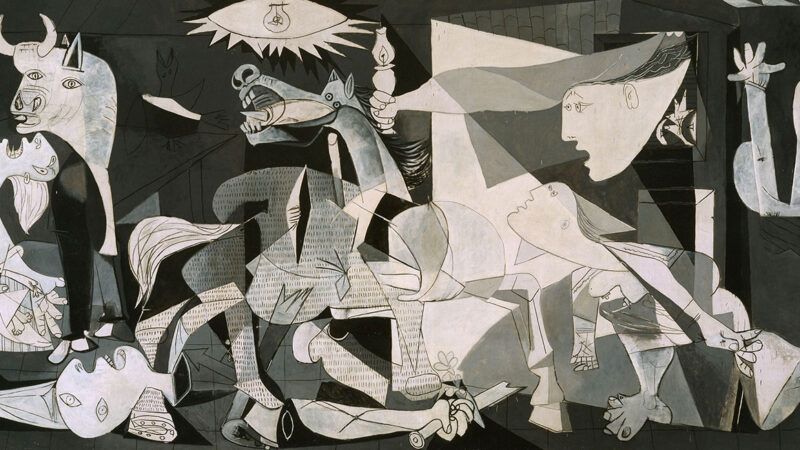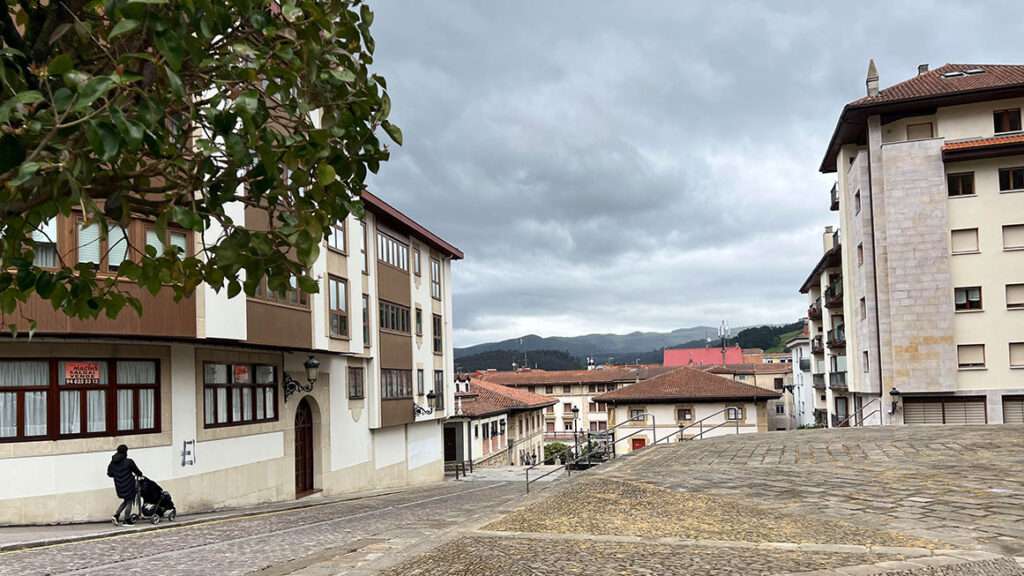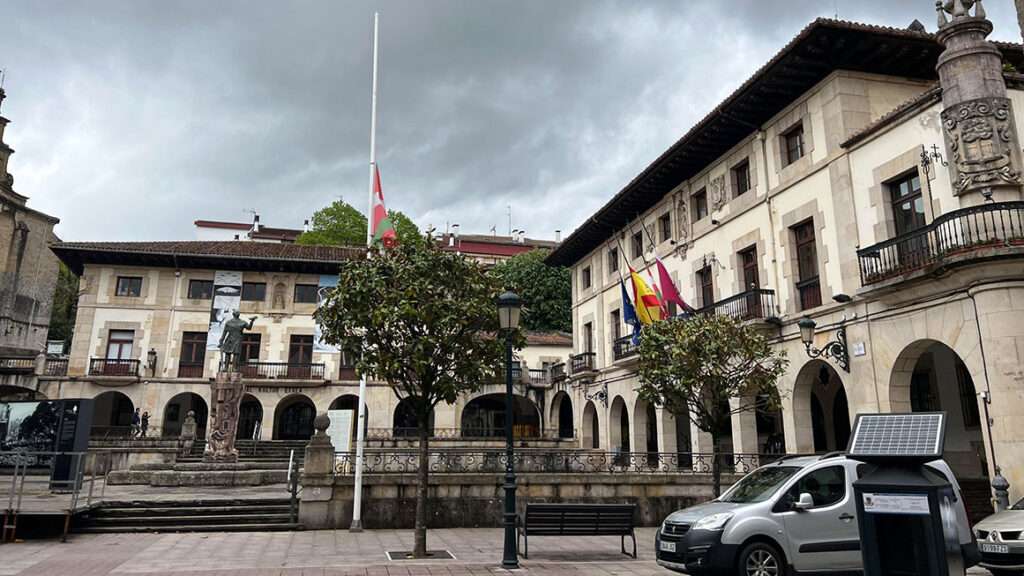Guernica's Recovery From Ruin
The bombing of a Basque town during the Spanish Civil War gave rise to art—and cultural resilience.

Before Mariupol, before Gaza, before Hiroshima and Nagasaki and Dresden and the Blitz, there was Guernica. The little Basque town in northern Spain was once the byword for state cruelty following the 1937 bombing of Guernica during Spain's civil war—an unprecedented air attack on a populated city that shocked the global conscience and inspired Pablo Picasso's most famous work, Guernica.
An atrocity is a weird thing for a place to be famous for, but neither tourists nor locals seem very fazed. Guernica, the painting, is such an abstract depiction of civilian suffering that visitors have no problem posing in front of it. Guernica, the town, is a center of Basque culture. For Basques (who know it as Gernika), the violence that moved Picasso nearly a century ago is merely one chapter in a long history of resilience in their quest for freedom.
Predating the Roman Empire and even the Celtic civilization before it, people along the Bay of Biscay have spoken Basque, a language with no known living relatives. Empires have risen and fallen, but Basque Country has preserved its unique culture and laws. From medieval times onward, Spanish monarchs would swear to uphold Basque traditions under a sacred tree in Guernica.
"It is a republic; and one of the privileges [Basques] have most insisted on, is not to have a king," wrote American Founder John Adams in 1786. "Another was, that every new lord, at his accession, should come into the country in person, with one of his legs bare, and take an oath to preserve the privileges of the lordship."
More than a century of Spanish revolutions and crackdowns gradually eroded Basque autonomy. Then, in July 1936, the pro-fascist Gen. Francisco Franco launched a mutiny against the Third Spanish Republic. In a bid for Basque support, the besieged Republicans quickly restored self-government to the region. By April 1937, Guernica was the last pro-Republican community standing between Franco's forces and the major city of Bilbao. With German and Italian air support, Franco moved to take the town.
"Guernica, the most ancient town of the Basques and the centre of their cultural tradition, was completely destroyed yesterday afternoon by insurgent air raiders," reported British war correspondent George Steer a day after the first wave of bombers struck. "In the form of its execution and the scale of the destruction it wrought, no less than in the selection of its objective, the raid on Guernica is unparalleled in military history."
"Guernica was not a military objective," Steer continued. "The object of the bombardment was seemingly the demoralization of the civil population and the destruction of the cradle of the Basque race."

Steer's report shocked Picasso, who had been commissioned by the Spanish Republic to make a display for the World's Fair in Paris. He abandoned his previous plans and painted Guernica within a few weeks. The artist's dramatic response to this tragedy—which was controversial at the time seeing as the World's Fair was meant to be a feel-good cultural exhibition—was showcased next to photos of dead children and propaganda films about Franco's cruelty.
What was once "unparalleled" too soon became routine. Following the raid on Guernica, the Imperial Japanese military launched a massive invasion of Shanghai. (A photo of a Chinese boy in the rubble, titled "Bloody Sunday," became another symbol of the brutality of air wars.) World War II saw air warfare escalate dramatically, culminating in hundreds of thousands killed in carpet bombing, firebombing, and atomic bombing.

Today, Guernica is a sleepy, peaceful town. Franco's death in 1975 marked Spain's return to a constitutional monarchy, restoring significant political autonomy to the Basque people. The Guernica town hall flies both a Spanish flag and a Basque flag while most other buildings don't bother with the Spanish one. A nearby gift shop sells Basque nationalist souvenirs—keychains with Basque crosses, fridge magnets with pastoral scenes—while Basque-language punk rock emanates from the speakers.
A replica of Guernica sits near the holy tree where the (now elected) leader of Basque Country once again takes the oath of office, and tourists flock to take photos next to the mural. What was once a jarring disruption to cultural tradition is now cultural tradition itself.
Editor's Note: As of February 29, 2024, commenting privileges on reason.com posts are limited to Reason Plus subscribers. Past commenters are grandfathered in for a temporary period. Subscribe here to preserve your ability to comment. Your Reason Plus subscription also gives you an ad-free version of reason.com, along with full access to the digital edition and archives of Reason magazine. We request that comments be civil and on-topic. We do not moderate or assume any responsibility for comments, which are owned by the readers who post them. Comments do not represent the views of reason.com or Reason Foundation. We reserve the right to delete any comment and ban commenters for any reason at any time. Comments may only be edited within 5 minutes of posting. Report abuses.
Please to post comments


Don’t know much history, do ya?
Minor quibble: Mussolini was Fascist because that was the name of his party. Everyone else co-opted the label but not the policies.
Major quibble: Franco revolted against the socialist / communist takeover of government. It was no more a republic by then than any such government. Ask yourself why the USSR supported the “Republic”.
Dictators on BOAF SIDEZ, yet you only call out the politically incorrect one.
Why is it that MAGA election deniers are so blissful at rewriting fascist history. No – the Spanish Republic was not ‘over’ before the coup that overthrew it and started the Spanish Civil War.
Are we denying the election in Venezuela or a different election?
Predating the Roman Empire and even the Celtic civilization before it, people along the Bay of Biscay have spoken Basque, a language with no known living relatives.
That really is resilient. There are only a handful of languages that still exist today with no ‘relatives’. Most died out long ago esp in the ‘Old World’ – like Sumerian.
Guernica was bombed by two Heinkel He 111s, one Dornier Do 17, eighteen Ju 52 Behelfsbomber, and three Italian Savoia-Marchetti SM.79 of the Nazi Condor Legion and its Italian allies. About 300 civilians were killed and a thousand injured
The total combined bomb load for the 24 bombers was 22 metric tonnes.
Four years later, about 25,000 civilians died when some 22,000 tonnes of bombs were dropped during the London Blitz.
A nearby gift shop sells Basque nationalist souvenirs—keychains with Basque crosses, fridge magnets with pastoral scenes—while Basque-language punk rock emanates from the speakers.
Something something preserve the culture something.
The Japanese recovered within a few years of the combined bombing during WW2. The Basque seem pretty lame in comparison.
Problem is that more people remember Picasso’s fingerpaintings than they do Guernica. People might look at Guernica and recognize Picasso, but they don’t recognize Guernica in it unless some preening prat in a very intentional bowtie explains it to them.
But then this is the arrogance inherent to all modernist/post-modern artists. It’s not about the subject, and it never was. It’s about themselves. Personal expression. This is what separated them from Romance and Renaissance artists, and what ultimately made Modernists unequivocally, indisputably inferior as a result.
For all you laymen out there, I’m going to let you in on a little art world secret: Picasso is crap, and anyone who likes him is a knuckle-dragging mouth-breathing moron. Fact. Not opinion. He didn’t create art, he created petulant little rebellions against the objective standards of Beauty (yes, capital-B). Guernica itself – arguably his most “famous” work – is barely a step-up from lazy graffiti.
I mean, sure, we can backtrack a little bit and start questioning the Impressionist/Abstract movement in general – but, we honestly don’t need to. By the 1900s (Picasso’s era), it had gone from “new takes on old forms” to “let’s just take a dump all over classical standards” – and Picasso makes it easy by drawing a Cubist line in the sand. To his credit, I sometimes wonder if this was a double-secret rebellion on behalf of Picasso to expose the stupidity of contemporary (“aesthetically relativist”) art appreciation. There’s enough evidence to think maybe that was the case – but either way, the gallery idiots won and to this day everyone thinks Picasso was great when he either A) wasn’t; or B) was intentionally screwing with them.
Either way, unless specifically educated on the piece, no casual observer looks at “Guernica” and thinks about Guernica. They think about Picasso. Which means it takes more away from that tragedy/travesty, than it could ever give to it.
I would argue that the only reason most people know anything at all about Guernica is because of the painting. Without the painting, this tragedy would be forgotten.
Not for the Basques.
Un uomo maleducato con cuore di piombo puro.
There’s not anything technically “wrong” with this article. But what the actual fuck? This same information was included (in more insightful fashion) in the copy of Lonely Planet I hauled around Spain in the 90s. Exactly what makes this topic relevant to libertarianism or relevant at all is beyond me.
The evolution of total war reflects the evolution of warfare itself. Warfare started out as local raids by people with very little back home trying to gain something for themselves from neighbors who had more. Later it became the method for settling disputes between monarchs and princes over titles and lands, with draftees paying the blood price. Now there is no excuse for claiming honor or glory in justifying war. The stakes are so high now that the only possible excuse – if it is one – for going to war is self-defense. Yet Americans continue to allow their government officials to push their buttons for an almost continuous state of warfare around the world to make it safe for democracy, or to eliminate terrorism or to protect our “vital national interests” like Persian Gulf oil or to “maintain stability in the region” while actually achieving the exact opposite of stability. American exceptionalism rules. And the civilian death count continues to mount amidst the destroyed infrastructure of hundreds of cities. It’s almost enough to make me despair for the human race.